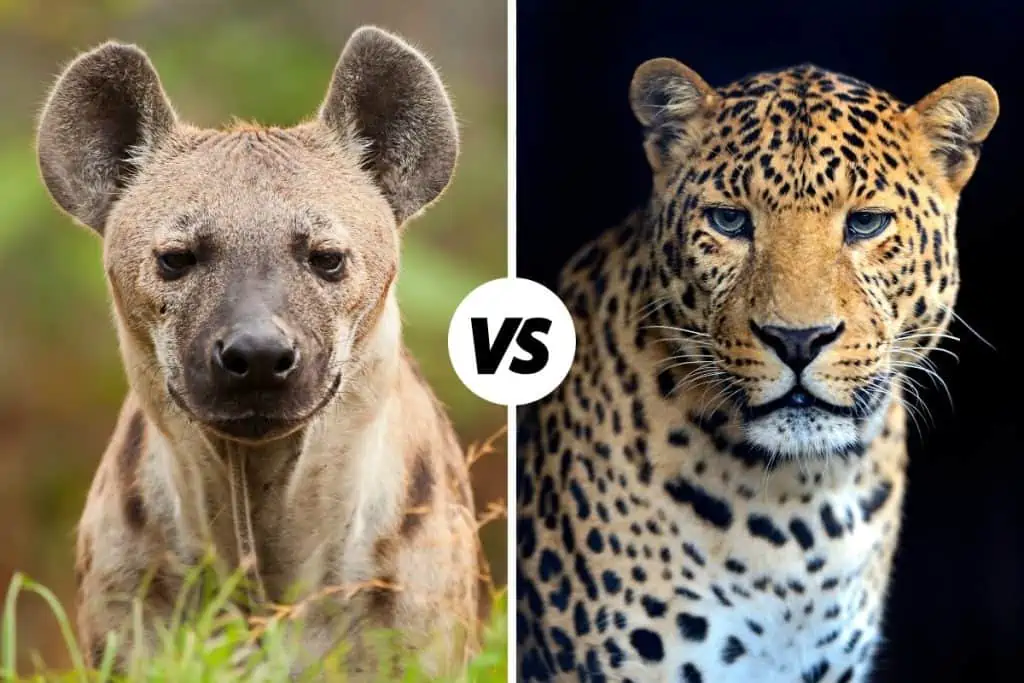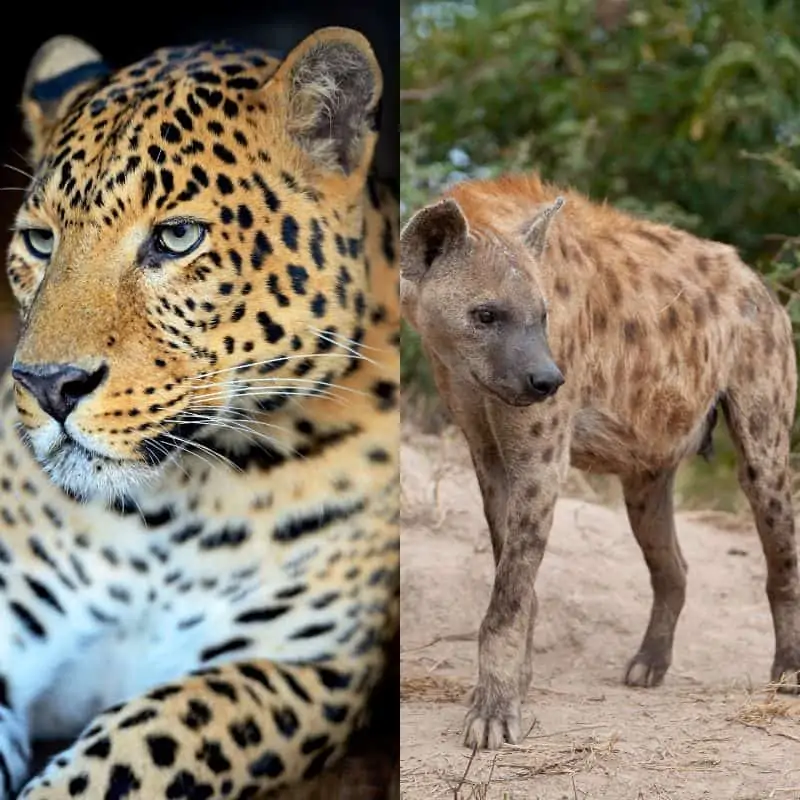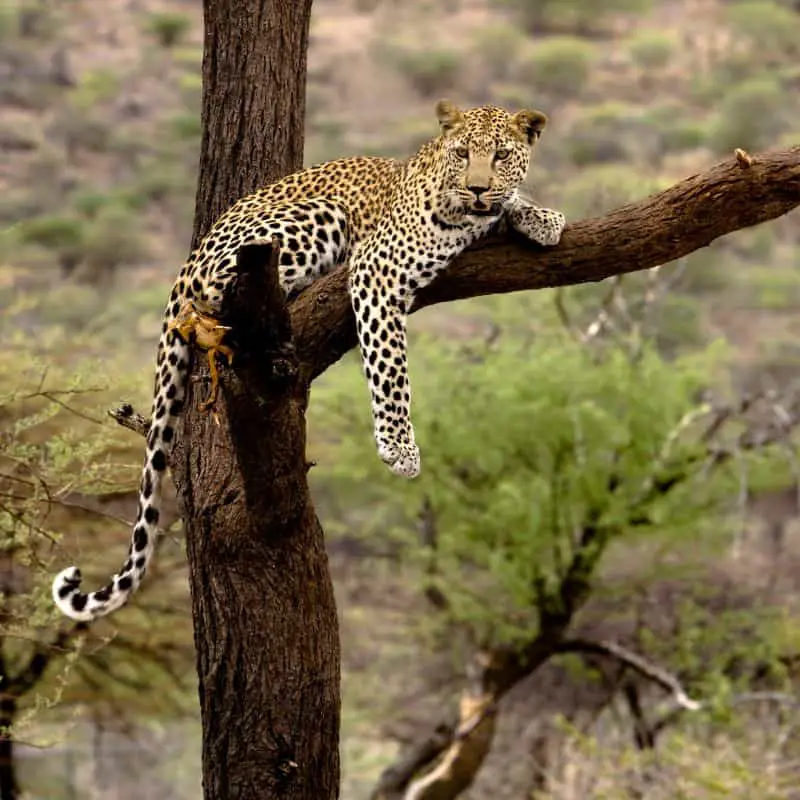Hyenas and Leopards are some of the most successful predators found in Africa (and other places), but they share very few commonalities. So how do these two animals both thrive being so different? Let’s look at hyenas vs. leopards and their differences.
The hyena and leopard are distinct species with varying characteristics, sizes, habitats, hunting methods, and social structures. Hyenas inhabit savannahs, while leopards prefer forests. Hyenas scavenge for food, whereas leopards are true predators. Hyenas form packs, whereas leopards live alone or in pairs.
This highlights the diversity between the two animals, but let’s look at this in more detail.

Main Differences Between Leopards And Hyenas
The key differences between a leopard and a hyena are numerous, ranging from physical characteristics to behaviors.
Physical Characteristics
Leopards are powerful animals with stocky bodies, short legs, and long tails. They have muscular bodies and can weigh anywhere from 66 to 176 pounds depending on the subspecies.
Their coats vary in color from pale yellowish to dark gold or reddish-brown. The coat is covered with dark spots called rosettes with no set pattern.
The rosettes are used to help the leopard blend into its environment while stalking prey or hiding from predators, providing camouflage in the dappled light and shadows of the forest.
The appearance of hyenas varies widely depending on the species. Spotted hyenas are generally the largest, with a head-and-body length that can reach up to 65 inches and can weigh up to 190 pounds.
All species have a powerful build, well-developed forequarters, and strong teeth and jaws. The hyena’s coloration ranges from gray to yellowish-brown or reddish-brown, and its mane can be long and shaggy or short and erect.
All four species have a characteristic gait that is unique among carnivorans, making them easy to recognize.

Habitats
Leopards are found in sub-Saharan Africa, northeast Africa, Central Asia, China, and India.
The habitat of leopards includes a variety of terrains, such as grasslands, deserts, savannahs, and forests. They are also able to live in more mountainous areas with rugged terrain.
Hyenas’ habitats include savannas, grasslands, woodlands, and even semi-deserts.
They are considered one of the most adaptable predators throughout Africa and India.
Hyenas can be found in dens or burrows underground, where they often live in groups known as clans.

Speed
Leopards are very fast and agile animals, which makes them excellent hunters.
They can run at a maximum speed of 58 kph (36 mph) making them capable of taking down large prey such as antelopes.
Hyenas are also fast animals, reaching speeds of up to 60 kph (37 mph). They are known for their scavenging abilities and can take down smaller prey such as rabbits and antelopes.
Sociality
Leopards are solitary and nocturnal animals. They come close only for mating, marking the boundaries with urine. They are excellent climbers and swimmers and have good camouflage capabilities.
Leopards communicate through scent marking, vocalizations, and face rubbing. They play an important role in the ecosystem by controlling prey populations and acting as top predators.
The behavior of hyenas is complex and varies between species. Generally speaking, they are highly social animals, living in large groups called “clans” that can include up to 80 animals.
Within the clan, they communicate using a variety of sounds, including growls, yelps, whoops, and giggles. Hyenas are also very territorial, and they will defend their home ranges aggressively to keep out intruders.
Hunting Behaviour
Leopards are highly adaptable predators, relying on ambush tactics and their powerful builds to surprise and overpower their prey. They have a variety of strategies for hunting, including stalking, chasing, crouching in wait, and even playing dead.
They use scent marking to advertise their presence and to locate prey. They also use vocalizations such as growls, hisses, and screams to indicate their presence and intimidate potential opponents.
Hyenas are opportunistic hunters that use a variety of hunting strategies depending on their environment. These can include pursuing prey in groups, stalking and ambushing, bone-cracking and scavenging.
By utilizing these behaviors, hyenas can make the most of limited resources and survive in difficult conditions.
Diet
Leopards are carnivorous, and their diet consists mainly of ungulates such as deer, antelope, pigs, and goats.
They also occasionally prey on smaller animals like hares and monkeys, as well as birds and reptiles.
In areas where larger prey is scarce, leopards may feed on livestock or even fish.
Hyena’s food includes scavenged carcasses, small mammals, fish, birds, reptiles, amphibians, grasses, berries, roots, and tubers.
They have been observed to consume carrion as large as zebras and wildebeest, as well as raiding poultry and domestic livestock.
Hyenas can also adapt their diet based on the availability of food sources and have been known to consume human refuse.
Lifespan
Leopards live for approximately 10 to 12 years in the wild and can live between 21 to 23 years in captivity.
Hyenas have a similar lifespan to that of Leopards, reaching approximately 10-12 years in the wild, and up to 31 years in captivity.
Threats
Leopards are classified as vulnerable or endangered due to threats such as illegal hunting and trading, habitat loss, climate change, overgrazing by livestock, poaching for international markets, and trophy hunting.
These threats put leopard populations at risk of extinction in the wild.
Hyena populations face threats from habitat loss, poaching, and competition for resources due to human settlements.
They may be killed out of fear or as a way of controlling their numbers, which can lead to further conflict with humans.
Conservation efforts are necessary to protect these animals and ensure their survival.

Conservation Efforts
Efforts are being taken up by several wildlife conservation organizations and communities worldwide.
They are educating people on the need to protect these species and promoting sustainable practices that can help reduce the impact of human activities on their habitats.
Conservation efforts for hyena populations have been successful due to their adaptability, with programs like Grootkolk Conservation Project in South Africa and research initiatives such as the Hyaena Specialist Group (HSG) helping to inform management decisions and raise public awareness.
Local communities have also been encouraged to become involved in protecting hyenas by providing financial incentives and assisting in research projects.
Final Thoughts On Leopard And Hyena Differences
Leopards and hyenas are very different animals with their strengths and weaknesses. Leopards are built for hunting, while hyenas are adapted to scavenging.
Both species rely on similar strategies for survival, and it is important to ensure their habitats remain preserved for future generations.
Conservation efforts can help these animals continue to thrive in our world.
